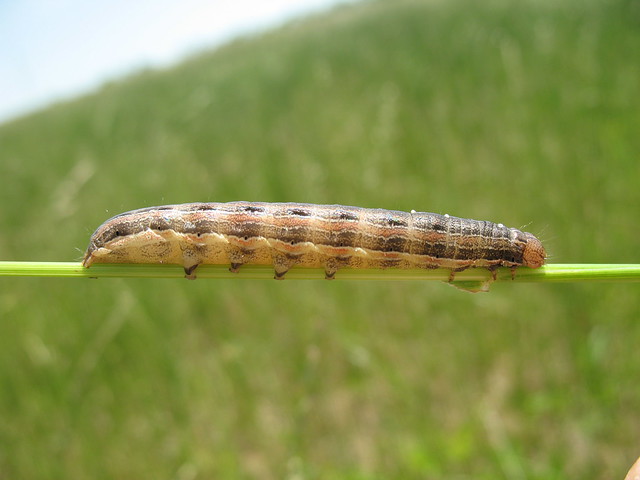Armyworms may look cute and innocent, but they can be pests that are detrimental for your vegetables and garden, This article is designed to share some techniques and methods to prevent your garden from an armyworm infestation. To save your garden from an armyworms attack, it is necessary to have an idea about its life cycle and how it damages plants.

What are Armyworms?
Armyworms include a number of species; but the army worm caterpillar is normally comprised of green, brown and yellow stripes on its body. Although, newly hatched larvae are difficult to distinguish than older larvae. In the larval stage, armyworms attack a variety of crops, grass and vegetables. They mostly invade crops after a cool and wet spring. Adult armyworms are gray, mottled moths (1.5” wingspan) and contains white marks and dark margins on its wings.
Armyworm Life Cycle
Armyworms lay a massive number of eggs in favorable condition on seedlings, leaves of older plants, and fluffy masses. It takes 10-15 day to hatch the tiny caterpillars which feed on plants for few weeks. After the pupae emerge, the turn into an adult after 10 days. The generations of the armyworms species grow rapidly up to 3 to 6 generation each season. The armyworms pupate in the winter season and become active in the warm season.
Armyworm Plant damage
Armyworms skeletonize the leaves of beans, cabbage, lettuce, tomatoes and corns. They become active in the spring season and attacks grasses and low ground plants. Its favorite host is corn and it feeds on corn whorls and corn ears and turns the ear into husk. Young corn is more vulnerable to an armyworms attack. The fall armyworms infest on grasses and graze-able pasture animals. They move in small armies and eat everything on their way. Armyworms cannot survive in freezing temperature and move to warmer regions.
How to Get Rid Of Armyworms
To prevent an armyworms attack at an early stage, be proactive and check your lawn and garden if there are any brown patchy areas where the plant has been eaten or if ther are any pest droppings. Check if there are armyworm moths with a white spot at each wing, it is an indication of an armyworms infestation in your garden.
If there are armyworms, there may be birds around your garden that feeds on them and protect your garden from pest. To minimize the armyworms attack, take good care of your garden, water them often, keep the grass short and apply a sufficient amount of fertizilzer and nutrients for healthy plant growth.
In early spring, larvae of the caterpillar pupates and you can easily find them underside leaves and in debris. Turn your soil and handpick the eggs of armyworms and drop them in soap water.
Methods to control armyworms
If you couldn’t control armyworms at the early stage it can completely destroy your crops and vegetables. To control the armyworms attack and to save your crops and garden you can use the following methods.
- Bacillus thuringiensis (BT) Spray: One of the most effective , naturally occuring soil bacterium, is Bacillus Thuringiensis. Also known as BT, this spray will get rid of your army worms very quickly. I have seen results as quick as a 1-2 days. SImply follow the directions on the BT sprway bottle and spray the mixture over your plants. It is a completely safe and natural occuring insecticide, which is why I highly praise the use of BT.
- Nematodes: Nematodes are released in the garden to catch pests, they can control about 200 types of pests. Nematodes feed on armyworm eggs, larvae and pupae and save your garden from damage.
- Spinosad: Application of Spinosad insecticide will help reduce an armyworms attack in your garden.